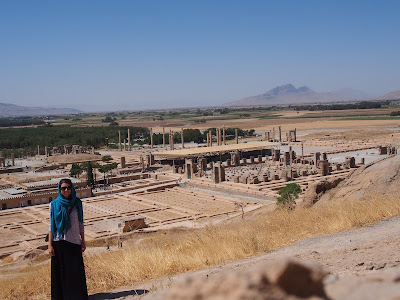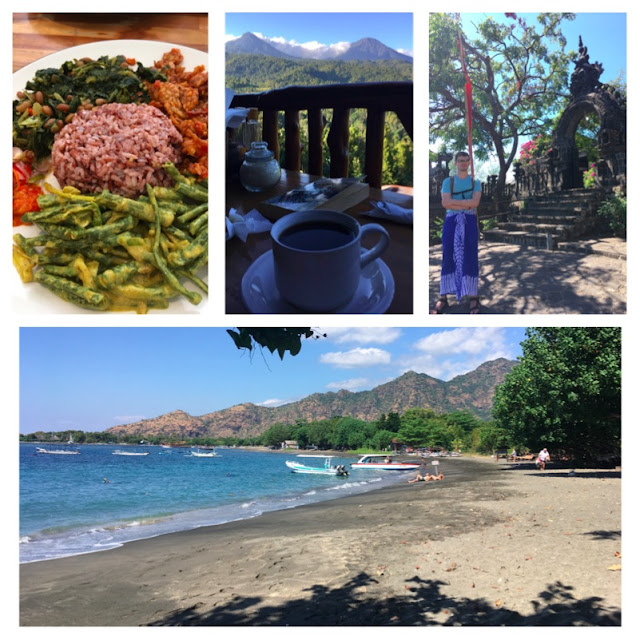Some Thoughts on Compulsory Hijab in Iran
It was a hot day at Persepolis, perhaps the hottest of our trip, and there was little shade to be found among the ancient ruins. In compliance with the laws of Iran, I was wearing far more clothing than I would have preferred in that weather - a long black skirt, a tunic top with 3/4-length sleeves, and the ubiquitous head scarf, worn any time I left my hotel room for the duration of my trip. Most of the time, the scarf wasn't so bad (although I was constantly pulling it forward to keep it from falling off). But on this particular day, in the heat of the desert sun, I felt like I was suffocating. It took all of my willpower not to yank it off of my head. Needing to escape the crowds, I climbed up towards the less-visited of the rock tombs in the hillside. The breeze grew as I climbed higher and I turned to face it so that the air could blow inside the scarf. And then I looked around and realized there was no one in sight, and I let the wind blow my scarf off my head, just for a few brief seconds before I pulled it back in place.
I touched a little on the topic of hijab in Iran previously, but after my friend Kelly emailed me with her Iranian friend's perspective, I knew i wanted to delve a little bit deeper into my understanding of and experience with hijab in Iran. These of course are just my opinions and observations from a brief time in the country. I'd love to hear opinions from others in the comments, especially if you've lived or traveled in Iran or other Islamic nations!
Hijab (or hejab) refers to a scarf that women wear to cover the head, neck and chest as part of the Muslim requirement of modesty. Sometimes it also refers to other items of clothing that meet this modesty requirement such as long sleeves, pants that cover the ankle, and clothing that does not show the shape of the woman. In Iran, women must wear hijab outside of the home to protect their modesty in the presence of unknown men. Inside the home, they generally can wear whatever they want.
As I mentioned before, Iranian women hadn't been required to wear hijab (though of course some chose to) since the 1920's, until the Ayatollah took power after the revolution of 1979. The new government was much more conservative, and hijab became compulsory outside the home for women and girls over 9. There is a "Morality Police" who can arrest or fine women on the street when they don't meet the requirements of hijab (among other offenses). The Morality Police are still active today, though arrests for clothing-related offenses have supposedly declined since President Rouhani took office. The bigger change, really, is that many women no longer fear the morality police they way the once did.
Kelly's friend, Farah, said:
Tell Mary that Iranian women are relentless in seeking freedom! They have suffered at the hands of muslims far too long and have had a long fight! They are the true feminists.
"relentless in seeking freedom" - I love this description! Women in Iran are pushing the boundaries of hijab, slowly but surely. Where they were once required to wear all dark colors, and to not have even a single strand of hair showing, many now wear bright head scarves that have become more fashion accessories than compulsory uniforms. They wear heavy makeup and dye their hair. They wear tight clothing that technically covers everything, but certainly doesn't leave any of their shape to the imagination. And some of them wear their head scarves so far back on the head that you wonder how they manage to stay on.
Farah referred me to a website, My Stealthy Freedom, which I found really fascinating - an Iranian woman, now living in the US, started it with a picture of her with and without her headscarf. Women began sending her pictures of themselves without the scarf, even if it's just for a second - a temporary rebellion against the system, a moment of freedom. The founder doesn't want to ban the scarf, but rather for women to have the choice of whether they want to cover or not. Many women DO want to wear hijab as part of their religious practice - and this has been a whole separate issue in Western countries that want to ban the scarf or the veil. Freedom must go both ways - to choose to cover, or to choose not to.
What really struck me was the desire to feel the wind in your hair... I was only there for a short time, but I wanted to feel the wind in my hair more than ANYTHING. I had those few seconds of rebellion at Persepolis, but it wasn't enough. So near the end of our trip, when our group hiked up above the tiny village of Abyaneh for a view and found we were the only ones there - most of the women let our scarves fall and left them down, reveling in the the temporary reprieve. Ten days we'd been wearing our scarves, and we couldn't wait any longer to feel the breeze.
As we boarded our flight from Tehran to Istanbul, we noticed scarves dropping one by one. Turkey is a secular country, though largely Muslim, and does not mandate that women cover their heads. We took one last head scarf selfie and then... FREEDOM!
In some ways, compulsory hijab is not the biggest obstacle that women in Iran have to overcome, but it has great symbolic meaning. To feel something so simple and elemental as the wind in your hair... it's certainly a freedom I've always taken for granted.
I touched a little on the topic of hijab in Iran previously, but after my friend Kelly emailed me with her Iranian friend's perspective, I knew i wanted to delve a little bit deeper into my understanding of and experience with hijab in Iran. These of course are just my opinions and observations from a brief time in the country. I'd love to hear opinions from others in the comments, especially if you've lived or traveled in Iran or other Islamic nations!
Hijab (or hejab) refers to a scarf that women wear to cover the head, neck and chest as part of the Muslim requirement of modesty. Sometimes it also refers to other items of clothing that meet this modesty requirement such as long sleeves, pants that cover the ankle, and clothing that does not show the shape of the woman. In Iran, women must wear hijab outside of the home to protect their modesty in the presence of unknown men. Inside the home, they generally can wear whatever they want.
Kelly's friend, Farah, said:
Tell Mary that Iranian women are relentless in seeking freedom! They have suffered at the hands of muslims far too long and have had a long fight! They are the true feminists.
"relentless in seeking freedom" - I love this description! Women in Iran are pushing the boundaries of hijab, slowly but surely. Where they were once required to wear all dark colors, and to not have even a single strand of hair showing, many now wear bright head scarves that have become more fashion accessories than compulsory uniforms. They wear heavy makeup and dye their hair. They wear tight clothing that technically covers everything, but certainly doesn't leave any of their shape to the imagination. And some of them wear their head scarves so far back on the head that you wonder how they manage to stay on.
Farah referred me to a website, My Stealthy Freedom, which I found really fascinating - an Iranian woman, now living in the US, started it with a picture of her with and without her headscarf. Women began sending her pictures of themselves without the scarf, even if it's just for a second - a temporary rebellion against the system, a moment of freedom. The founder doesn't want to ban the scarf, but rather for women to have the choice of whether they want to cover or not. Many women DO want to wear hijab as part of their religious practice - and this has been a whole separate issue in Western countries that want to ban the scarf or the veil. Freedom must go both ways - to choose to cover, or to choose not to.
(video courtesy of Vox, via YouTube)
What really struck me was the desire to feel the wind in your hair... I was only there for a short time, but I wanted to feel the wind in my hair more than ANYTHING. I had those few seconds of rebellion at Persepolis, but it wasn't enough. So near the end of our trip, when our group hiked up above the tiny village of Abyaneh for a view and found we were the only ones there - most of the women let our scarves fall and left them down, reveling in the the temporary reprieve. Ten days we'd been wearing our scarves, and we couldn't wait any longer to feel the breeze.
In some ways, compulsory hijab is not the biggest obstacle that women in Iran have to overcome, but it has great symbolic meaning. To feel something so simple and elemental as the wind in your hair... it's certainly a freedom I've always taken for granted.









You should check out some of Kiana Hayeri's photography projects. She's an Iranian expat bouncing back and forth between Toronto and Tehran who has done a lot of work on contemporary youth culture, specifically how westernized kids push the boundaries imposed by their country's rich old men. This post made me think of her http://www.kianahayeri.com/beyond-the-veil series in particular.
ReplyDeleteReally interesting stuff - thanks, Brendan!
DeleteThank you for raising awareness in this issue. It is very kind of you.
ReplyDeleteTo be frank, there isn't anything to be 'modest' about our bodies.
If they believe in god so firmly, then why they hide away human body which is created by god?
The Iranian regime's excuse for compulsory hijab is that 'men cannot control themselves seeing unveiled women'. I cannot believe in 21st century there is still such childish nonsense.
Indeed, some ignorant people choose to pick on others' lives rather than turning themselves into the beautiful nature and magnificent views in front of them.
Regime change is the only chance, and hope there is no more crazy religions and ideologies to dominate our lives.